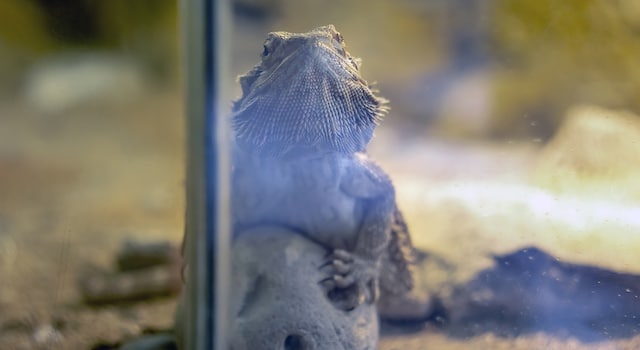
Introduction to Cleaning a Bearded Dragon Tank
Keeping your bearded dragon’s tank clean and hygienic is essential for their health and well-being. A dirty, unkept tank can smell bad and harbor harmful pathogens like bacteria and fungi that could make your bearded dragon unwell. These pathogens can cause health issues such as respiratory infections, skin infections, and mouth or tail rot.
When maintaining your bearded dragon’s tank, you primarily want to focus on cleaning and disinfecting. Both are essential for keeping the tank hygienic and preventing the growth of harmful pathogens.
So, how do you clean a bearded dragon’s tank, what supplies do you need, and why is it important? This article will tell you the step-by-step process.
Cleaning vs. Disinfecting: What’s the Difference?
- Cleaning: Refers to removing visible dirt, grime, and organic materials from the surface. This includes glass walls, platforms, food and water dishes, and enrichment items such as branches, hideouts, and rocks. Daily cleaning should be done to remove any soiled bedding and wipe down surfaces to remove dirt and grime. Deep cleaning should be done every 2-3 weeks, depending on the size of the tank and how quickly it becomes soiled.
- Disinfecting: This refers to killing germs, viruses, bacteria, and fungi on the surfaces that could cause health problems in bearded dragons and a foul-smelling environment. This is similar to using antiseptic solutions on a wound to disinfect and kill harmful microorganisms that could cause infections and foul smells. Disinfecting should be done after you have done a deep clean every 2-3 weeks to maintain a hygienic environment.
Supplies Needed
- Non-toxic dishwashing liquid or white vinegar and hot water (for cleaning).
- Reptile/veterinary-grade disinfectant (F10 or equivalent).
- Clean sponges, microfiber cloths, and scrub brushes.
- Spray bottle for disinfectant.
- Rubber gloves.
- Optional: Steam cleaner.
- A carrier or plastic tub (to house your bearded dragon in).
Step-by-Step Guide to Cleaning the Tank
Step 1: Remove Your Bearded Dragon
First, remove your bearded dragon from their tank and place them in a separate pet carrier or a plastic storage tub with large ventilation holes throughout. Line the carrier with paper towels and place a shallow water dish inside so your bearded dragon can stay hydrated. You should never clean and disinfect the tank with your bearded dragon inside.
Step 2: Taking Out All Accessories and Substrate
The next step is removing all the accessories like food and water dishes, hides, decorations, and substrate. You want to clean these separately to remove dirt and grime. This also ensures that you can easily clean the sides and bottom of the tank without anything getting in the way.
Step 3: Clean Accessories
Start washing the accessories in hot water using a non-toxic dishwashing liquid or diluted white vinegar solution. Use a sponge or scrub brush to remove stubborn dirt and grime. Then, rinse each accessory thoroughly under warm water to remove any soap residue. Spray non-porous accessories (tiles, ceramic dishes, and hideouts) with veterinary-grade disinfectant and leave for 20-30 minutes. Follow the directions on the label for the correct dilution and usage instructions.
Step 4: Clean the Tank Surfaces
Wipe down all the tank walls, floors, and lids with non-toxic dishwashing liquid or diluted white vinegar. Use a microfiber cloth or kitchen sponge to remove stubborn dirt and grime. Rinse the sponge or cloth and wipe away any soap residue with plain water.
Step 5: Disinfect the Tank Step
Spray all tank surfaces with veterinary-grade disinfectant (such as F10) and leave on for 20-30 minutes. Wipe any residue until the glass is clean and there are no streaks. Wait at least 15 minutes for the tank to air dry before adding the clean substrate and accessories.
Specific Notes on Cleaning Materials
Avoid using homemade disinfectant solutions like baking soda or vinegar. They can be used to clean the tank and accessories but cannot kill most bacteria and viruses. Instead, use a veterinary-grade disinfectant after a homemade cleaning solution and allow enough contact time (20-30 minutes) to kill harmful microorganisms.
The Role of Veterinary-Grade Disinfectants and Why It’s Recommended
Veterinary-grade disinfectants are specialized cleaning agents that eliminate harmful microorganisms like bacteria and viruses. According to the Merck Veterinary Manual, disinfectants should ideally have a broad spectrum, potent germicidal activity, and a rapid onset and long-lasting effect. They should not be prone to the development of resistance in target microorganisms and be able to withstand environmental factors such as pH, humidity, and temperature.
Compared to cleaning solutions like diluted white vinegar and dishwashing liquid, veterinary-grade disinfectants effectively kill harmful pathogens and have undergone rigorous testing and approval by regulatory bodies. They are usually pH-neutral and don’t cause any skin irritation, so it’s not necessary to rinse any residue off. And lastly, unlike many traditional cleaners, they are designed to be safe and non-toxic to reptiles and other pets.
Certain reptile stores, vet clinics, and online retailers can purchase veterinary-grade disinfectants. F10 SC is a popular concentrated veterinary disinfectant that is safe to disinfect a bearded dragon’s tank and accessories.
Tips for Specific Challenges
1. How to Handle Stubborn Grime or Stains on Decor
Handling stubborn grime or stains on decor requires extra effort, especially if the material is delicate or porous. The first method you should try is soaking the decoration in a white vinegar and hot water solution (with a 1:1 ratio) for 20-30 minutes. The vinegar’s acidic nature should help loosen stubborn grime or stains and remove odors. This is ideal for any ceramic, plastic, or metal decorations. Afterward, you should be able to scrub off any remaining dirt.
For tough stains, try using a baking soda paste (a mixture of water and baking soda) and letting it sit for 15-20 minutes before rinsing it off.
2. Consider Avoiding Using Rock Backgrounds
Some rock backgrounds can be challenging to clean and disinfect, especially if they are made from Styrofoam. You may want to avoid using any permanent rock backgrounds in the tank and use a reptile backing poster for the outside of the tank instead.
3. Best Practices for Cleaning Porous Materials
Porous materials such as driftwood and untreated wood accessories can be effectively cleaned correctly. First, you should use a scrub brush to remove any visible dirt, grime, or feces from the porous materials. You then want to soak the porous materials in a diluted disinfectant solution, ensuring it’s completely submerged for about 30-60 minutes. You can dry the materials in the sun afterward, which may take a day or two. Only put porous materials back into the enclosure once completely dry to prevent bacterial or mold growth.
Preventative Cleaning Habits
Practicing preventative cleaning habits to keep the tank clean in between deep cleanings. Spot cleaning, ideally done daily, involves removing leftover food and small sections of soiled substrate and using a damp cloth to remove any dirt or grime from the surfaces in the tank. You should also wash the food and water bowl with non-toxic dishwashing liquid or diluted white vinegar at least once daily.
Conclusion
A consistent cleaning routine is essential for your bearded dragon’s health and well-being. It ensures their environment is clean, hygienic, and free of harmful microorganisms that could cause health issues or foul smells. You should aim to clean the tank every 2-3 weeks and spot clean daily. During a deep clean, you should first clean the tank and accessories thoroughly and then start the disinfectant process using a veterinary-grade disinfectant like F10 SC.



